
Artemisia is a large, diverse genus of plants belonging to the daisy family Asteraceae, with between 200 and 400 species. Common names for various species in the genus include mugwort, wormwood, and sagebrush.
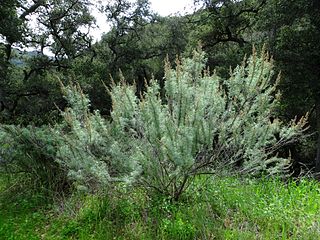
Artemisia californica, also known as California sagebrush, is a species of western North American shrub in the sunflower family.

Artemisia douglasiana, known as California mugwort, Douglas's sagewort, or dream plant, is a western North American species of aromatic herb in the sunflower family.

Anaphalis margaritacea, commonly known as the western pearly everlasting or pearly everlasting, is an Asian and North American species of flowering perennial plant in the family Asteraceae.

Artemisia pycnocephala is a North American species of sagebrush in the sunflower family, known by the common names beach wormwood, sandhill sage, and coastal sagewort.
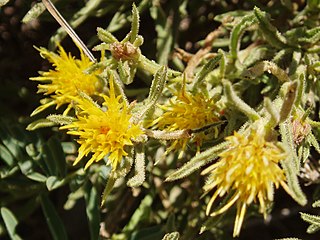
Ericameria discoidea, commonly known as whitestem goldenbush or sharp-scale goldenweed is a species of flowering shrub in the family Asteraceae. This plant is native to the western United States from California, Oregon, Nevada, Utah, Colorado, Idaho, and Montana.

Ericameria nana is a North American species of flowering shrub in the family Asteraceae known by the common names dwarf goldenbush and rubberweed. It is native to the western United States from eastern California, southeastern Oregon, Nevada, Idaho, Utah, and southwestern Montana.
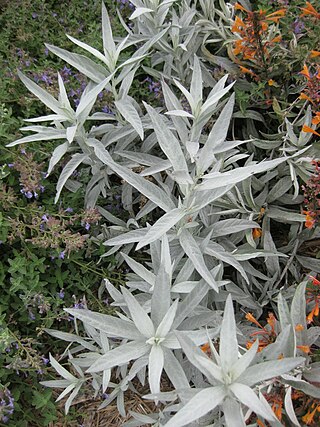
Artemisia ludoviciana is a North American species of flowering plant in the daisy family Asteraceae, known by several common names, including silver wormwood, western mugwort, Louisiana wormwood, white sagebrush, lobed cud-weed, prairie sage, and gray sagewort.

Artemisia arbuscula is a North American species of sagebrush known by the common names little sagebrush, low sagebrush, or black sagebrush. It is native to the western United States from Washington, Oregon, and California east as far as Colorado and Wyoming. It grows in open, exposed habitat on dry, sterile soils high in rock and clay content.

Artemisia bigelovii is a North American species of sagebrush known by the common name Bigelow sagebrush or flat sagebrush. It grows in the deserts of the southwestern United States.

Artemisia michauxiana is a North American species of wormwood in the sunflower family. It is known by the common names Michaux's wormwood and lemon sagewort. It is native to the western United States and Canada. It grows in mountain talus habitats in subalpine to alpine climates.
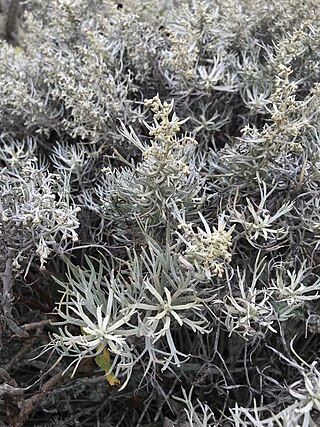
Artemisia nesiotica is a rare California species of sagebrush in the daisy family, known by the common name island sagebrush. It is endemic to the Channel Islands of California, found on 3 of the 8 islands.

Artemisia palmeri is a rare species of sagebrush known by the common names San Diego sagewort and Palmer sagewort.

Artemisia rothrockii is a North American species of sagebrush known by the common names timberline sagebrush and Rothrock's sagebrush.

Chaenactis suffrutescens is a species of flowering plant in the aster family known by the common name Shasta chaenactis.

Allium bisceptrum, also known as the twincrest onion or aspen onion, is a high elevation plant native to western United States. It is a perennial that thrives under damp and shady conditions or open meadows in California, Arizona, New Mexico, Nevada, Oregon, Washington, Idaho, and Utah.

Artemisia norvegica is a species of flowering plant in the aster family known by the common names alpine sagewort, boreal sagewort, mountain sagewort, Norwegian mugwort, arctic wormwood, and spruce wormwood. It is found in cold locations in Eurasia and high altitudes and high latitudes in North America.
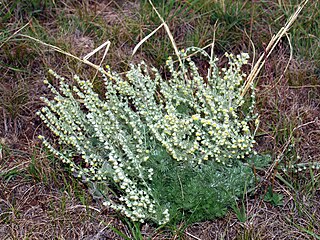
Artemisia frigida is a widespread species of flowering plant in the aster family, which is known as the sunflower family. It is native to Europe, Asia, and much of North America. In parts of the north-central and northeastern United States it is an introduced species.
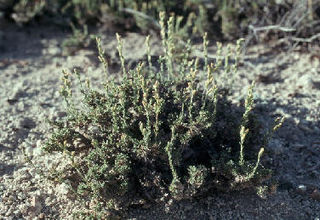
Artemisia pygmaea is a North American species of sagebrush in the aster family known by the common name pygmy sagebrush.
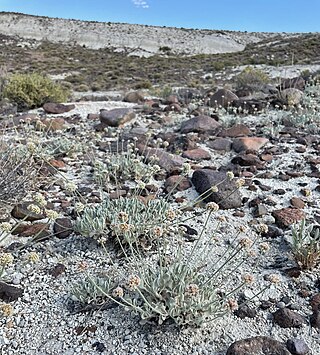
Eriogonum diatomaceum is a species of wild buckwheat known by the common name Churchill Narrows buckwheat. It is endemic to Nevada in the United States, where it is known only from the Pine Nut Mountains in Lyon County. It is limited to the Churchill Narrows near Fort Churchill State Historic Park. This plant was discovered in 1997 and described to science in 2002.





















